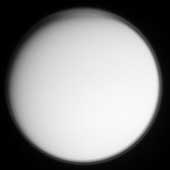|
COMETS EARTH JUPITER KUIPER BELT MARS MERCURY METEORITES NEPTUNE OORT CLOUD PLUTO SATURN SOLAR SYSTEM SPACE SUN URANUS VENUS ORDER PRINTS
PHOTO CATEGORIES SCIENCEVIEWS AMERICAN INDIAN AMPHIBIANS BIRDS BUGS FINE ART FOSSILS THE ISLANDS HISTORICAL PHOTOS MAMMALS OTHER PARKS PLANTS RELIGIOUS REPTILES SCIENCEVIEWS PRINTS
|
Related Documents
Download Options
High-altitude haze and perhaps cloud layers are visible in this imaging science subsystem image acquired on Oct. 24, 2004, as the Cassini spacecraft neared its first close encounter with Titan. The image was captured at a distance of about one million kilometers (620,000 miles) using a near-ultraviolet filter, which is sensitive to scattering by small particles. The Sun preferentially illuminates the southern hemisphere at this time of year, and the northern day-night terminator is visible at the upper boundary. The well-known global detached haze layer, hundreds of kilometers or miles above Titan's surface, is visible as a thin bright ring around the entire planet. This layer is produced by photochemical reactions. At the northern high-latitude edge of the image, additional striations are visible, caused by particulates that are at a high enough altitude to be illuminated by the Sun near the horizon despite the surface below being in darkness. These striations may simply be caused by wave perturbations propagating through the detached haze, or they may be evidence of additional regional haze or cloud layers not present at other latitudes. |
